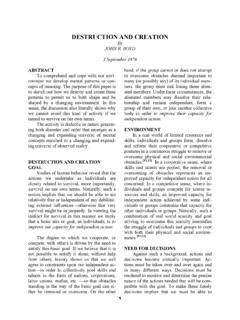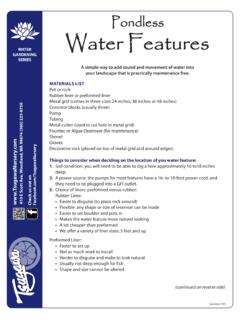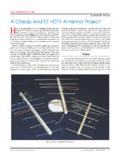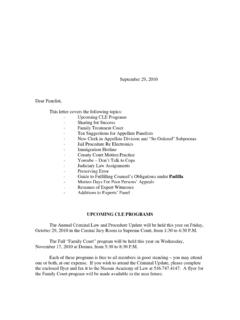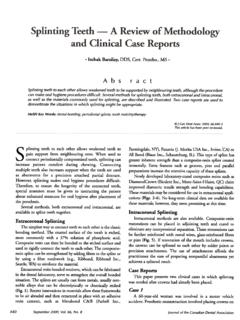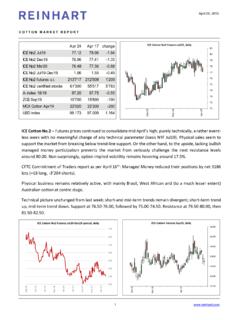Transcription of Laminating problems and solutions - mactac.eu
1 Technical Bulletin Laminating problems & solutions Page 1 of 3 TECHNICAL BULLETIN - V2- september 2012 Laminating problems and solutions issues: Few laminator problems look worse than bubbles under the film. Bubbles are caused by a lot of problems : insufficient tension on the supply roll; feeding the leading edge of the print too quickly into the laminator; too much heat on a wet print, causing "outgassing" of the ink; the adhesive not bonding properly to the media, and others. Insufficient tension causes bubbles when air gets trapped between the film and image because the film wasn't taut as it entered the nib (caused by lack of supply roll tension).
2 Insufficient tension is obviously fixed by adjusting the tension of the feed spool to the proper specifications for the type of film you're using. Thinner film needs less tension, for instance. Too little supply roll tension will cause bubbles before it will cause wrinkles in the film Feeding too quickly causes bubbles if the item is pushed into the nip faster than the speed of the laminator. The solution to this problem is too obvious to mention. The heat issue like hot spots is a key problem when Laminating inkjet prints. Inkjet printers dump a lot of ink onto the print, and a rushed operator may try to laminate the image before the ink is completely dry.
3 The problem can be exacerbated by the fact that if a laminator is allowed to sit for extended periods of time without the rolls turning, there can be varying degrees of temperature on different parts of the rolls. This creates areas called "hot spots." If you're running a laminator at 85 c, the point where the rolls sit together can easily become a hot spot of 95 c. When a moist inkjet print encounters one of this hot spot, the ink can easily boil, creating bubbles. Among the solutions to heat-related bubbling is not to let your rolls sit idle for extended periods of time, to speed up your laminator so less heat gets into the print or to work with a t about max 40 c and always use the appropriate pressure.
4 The silvering is caused by the capture of tiny bubbles of air. It looks like a hazy or reflective area in the lamination. It may go unseen over light areas of an image, but will be more obvious over dark or black areas. Silvering is usually caused by too low an operating temperature. Silvering is most often seen when a machine is not given time to warm up or if the film temperature drops too low. When a large machine is warmed up without the motor on, one side of each Laminating roll remains relatively cool. When lamination is begun, a pattern of repeated silvering can be seen each time the cool side of a roller is applied to the lamination.
5 "cool spots"--areas that aren't hot enough to melt the adhesive. If you see bands of silvering alternating with bands of properly adhered areas, it means one part of your roller was too cool. Pay attention to watch for any defect which repeats. This is typical of debris, damage, or low temperature on a section of the roller. On the other end, bubbles can also be caused if the adhesive doesn't bond properly to the image. It can look like a sheen on your image. Bonding problems can also be caused by inadequate heat, inadequate or uneven pressure, or too much speed.
6 Inadequate pressure can cause silvering because the film wasn't pressed onto the image hard enough, preventing the adhesive from properly bonding. Technical Bulletin Laminating problems & solutions Page 2 of 3 issues: The film will wrinkle if there is not enough supply roll tension. Any laminator needs a certain amount of resistance to the unwinding of the supply rolls so that the film lays flat as it goes into the nip of the Laminating rollers. Thinner film needs less tension, thicker film needs more. Also respect the Laminating t of 40 c to avoid wrinkling due to damp materials during Laminating process.
7 The moisture content of the printed substrates must be the lowest. peel issues: The industry term "orange peel" refers to the very fine wrinkles or waves in the laminate. This is a common condition of using too much heat. Simply adjust the temperature to a lower setting. NOTE: A quick fix can be to speed up the laminator. As the film runs at greater speeds, the actual "film" temperature is reduced. Some orange peel may occur when Laminating prints with a lot of solvent residues or oil based , blistering, dimpling issues due to moisture: This occurs by the natural moisture in the item making the item swell near the printing.
8 When too much heat is used, the moisture is dried out, but the areas that swelled up distort the item from laying flat. This can be also caused by not enough tension, and uneven pressure. , curling and other distortion issues due to tension & pressure: Several common problems are caused by the wrong amount of tension or pressure on your laminator. Users should start with as little tension as possible and then add more as needed, rather than starting with a lot and loosening up 4 common problems with laminated prints related to the wrong amount of tension or pressure are "infeed waves," "print curl", "boat wake" and ripples.
9 Infeed waves are mars in the finished product that result from the original image being somehow distorted before it went in. For instance, if there is insufficient tension on the image as it's going in, it could end up crooked or folded as it enters the nib of the rolls. When you're feeding an image into the laminator, make sure it's parallel to the roll. Once it gets pulled in, grab the back of the image and hold it taut so any wrinkles get smoothed out before they enter the nib. Print curl is what you get when you unroll an image and it wants to roll itself back up again.
10 A little bit of this is normal but if the print doesn't lay flat after some gentle smoothing, you've got a problem. Print curl happens when one side of an encapsulated image changes size out of proportion to the other side, causing the print to curl towards the smaller side. This can be caused if the user puts a heavy laminate on the top side, and something thin and cheap on the back, but doesn't adjust the tension to allow for the different dimensional stabilities of both Technical Bulletin Laminating problems & solutions Page 3 of 3 types of film.

